Debbie Young's Blog, page 17
August 11, 2021
Diary Dilemma
 I keep all my old diaries – these date back to my childhood
I keep all my old diaries – these date back to my childhoodAs the world begins to open up again, I buy a new mid-year diary twice the size of my old one.
After crossing out practically every event in the last sixteen months due to Covid restrictions, I’m hoping I’ll need more diary space to make up for lost time. I have so many missed social engagements with family and friends to make up for, not to mention practical appointments with doctors, dentists, hairdressers and garages.
My favourite time for appointments is 11am. With 11 as my default, I am more likely to remember when my meetings are and to turn up on time. Similarly, when I’m working at my desk, I generally down tools at 11 for a coffee break.
 Is there honey still for elevenses? (Image by Mariana Ibanez via Unsplash.com)
Is there honey still for elevenses? (Image by Mariana Ibanez via Unsplash.com)I follow Winnie-the-Pooh’s advocacy for elevenses – “Pooh always liked a little something at eleven o’clock in the morning” – although I don’t share his taste in refreshments.
Rabbit said, ‘Honey or condensed milk with your bread?’ Pooh was so excited that he said, ‘Both,’ and then as not to seem greedy, he added, ‘but don’t bother about the bread, please.’*
My plan for more outings is soon scuppered by increased traffic congestion. (Yes, I know, I’m contributing to those traffic jams by driving places.) One Friday afternoon in early July, when it takes me two hours to drive the six miles between Junctions 18 and 19 on the M4, I resolve to avoid motorways at weekends until after the summer holidays.
Consequently, the Monday to Thursday pages of my diary are soon choc-a-bloc, while the rest are almost empty. But that’s fine by me. Being self-employed, I am fortunate in being able to work whichever days I choose, including weekends.
My next challenge is to fit a whole week’s work into Friday, Saturday and Sunday.
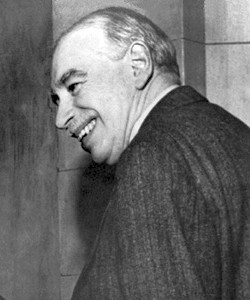 John Maynard Keynes, looking forward to a 15-hour working week (Image: public domain)
John Maynard Keynes, looking forward to a 15-hour working week (Image: public domain)Nearly 100 years ago, leading economist John Maynard Keynes predicted labour-saving technology would soon shorten the standard working week to 15 hours.
In my teens (not quite 100 years ago), futurists were still predicting a four-day week for us all. Even so, to avoid burning the midnight oil, what I really need is a five-day weekend.
But after more than a year of not being able to tell one day from another, that’s a good problem to have.
(This post originally appeared in the August 2021 edition of the Hawkesbury Parish News *Copyright The estate of A A Milne)
Summer Holiday Reading
 Two books in my Sophie Sayers Village Mystery series take place in the summer holidays:
Two books in my Sophie Sayers Village Mystery series take place in the summer holidays:
Best Murder in Show (first in series) revolves around the annual horticultural show, where Sophie finds a dead body on a float in the village carnival
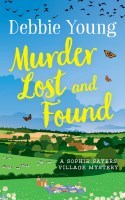 Murder Lost and Found (seventh in series) takes place just after the end of the academic year at the village school, when Sophie finds a dead body in the school’s lost property cupboard
Murder Lost and Found (seventh in series) takes place just after the end of the academic year at the village school, when Sophie finds a dead body in the school’s lost property cupboard
All of my novels are available in paperback online or to order from your local bookshop and in ebook from all the popular ebook store sites. Best Murder in Show is also available as an audiobook from all the major audiobook sites including Audible – or you can buy it at a very special rate via my AuthorsDirect shop here.
Summer Diary DateThe highlight of this month in my diary will on Saturday 28th August – the fabulous Hawkesbury Horticultural Show, in the Cotswold village of Hawkesbury Upton where I’ve lived for over thirty years. I’ll be manning the Hawkesbury Upton Literature Festival stall – if you’re at the Show, do come and find me and say hello!
Find out more about the Hawkesbury Horticultural Show at www.hawkesburyshow.org)
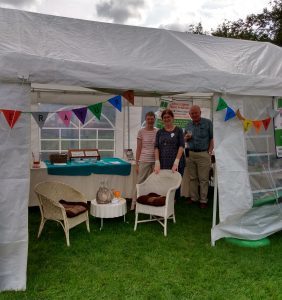 A A Abbott, one of the authors at the pop-up lit fest, kindly provided this photo
A A Abbott, one of the authors at the pop-up lit fest, kindly provided this photo
August 4, 2021
How Blue Was My Hilltop
In my Young By Name column for this month’s Tetbury Advertiser , I wrote about a sight I’d like to spot more often in the Cotswolds – although they are beautiful enough as they are!
Driving along a lane in the high fields near Newark Park, I spot a mirage-like splash of blue big enough to fill a field. Or is it mauve? Rippling in the late afternoon breeze, the flowering crop is changing colour as readily as the two-tone tonic suits favoured by Mods in the 1960s. Oil poured on water morphs from black to rainbow hues because the floating film is just a molecule thick, but when I park alongside the field, these plants are chest high.
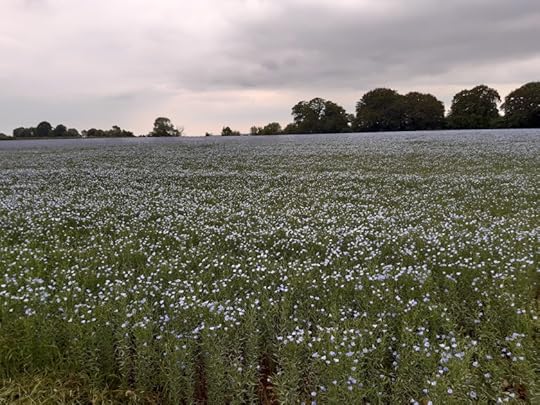
I’m used to seeing cars stopping on the roadside in early summer to photograph swathes of pillar-box red poppies among the crops. A few years ago, a field just off the A46 was as densely carpeted with poppies as the famous scene in The Wizard of Oz. An instant tourist attraction, it triggered a proliferation of social media selfies.
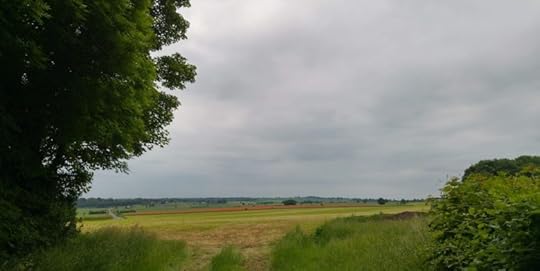 The arresting view of Hawkesbury’s poppy field caused may motorists to divert from the A46 for a closer look
The arresting view of Hawkesbury’s poppy field caused may motorists to divert from the A46 for a closer lookThe mauve flowers – or are they blue? – in this field by Newark Park have a far subtler beauty. It is of course a field of flax, the first I’ve seen for a long time, and an increasingly rare sight in the Cotswolds. How I wish I could substitute flax for the ubiquitous rapeseed, whose vivid flowers look all wrong in our gentle landscape. They also make me sneeze like one possessed, a yellow morning mist floating above their fields like mustard gas. While I don’t expect farmers to choose crops for their good looks, I do wish flax could be more profitable.
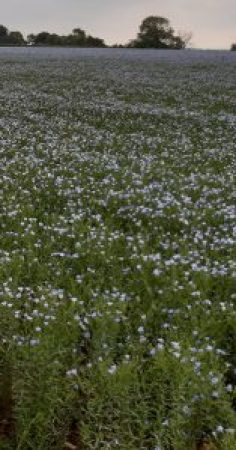
Flax, aka linseed, is certainly a useful and versatile crop. Chez Young, we add linseeds to our breakfast cereal and salads for their health benefits. Linseeds are rich in fibre, protein, Vitamin B, minerals and Omega 3 fatty acids.
I wish the latter didn’t sound so unappetising: “Mmm, fatty acids,” said Homer Simpson, never.
Research indicates that linseeds improve digestive health and lower blood pressure, bad cholesterol and cancer risk. If that’s not enough to win your heart, linseed oil goes into paints, varnishes, animal feeds and cricket bats.
The stalk, with fibres three times stronger than cotton, is the source of linen. The Ancient Egyptians considered linen a symbol of purity and allowed only priests and mummies to wear it. Much as I love linen clothes, that’s not a sacrifice I’d be prepared to make. Flax fibres are also used in the manufacture of cigarette papers (boo!) and teabags (hurrah!)
So why don’t we grow more flax on the rolling hills of the Cotswolds? When I google its preferred growing conditions, I discover it’s not just a matter of money. Flax thrives on alluvial soil, ie rich in sediment deposited by running water on a floodplain. With an average elevation of over 100m in the Cotswolds, I’m guessing alluvial soil is not our long suit.
As the sky begins to darken ahead of a thunderstorm, I realise I must make the most of this rare scene, so I capture it on my smartphone before returning to my car – and, like a tourist on my home turf, to social media.
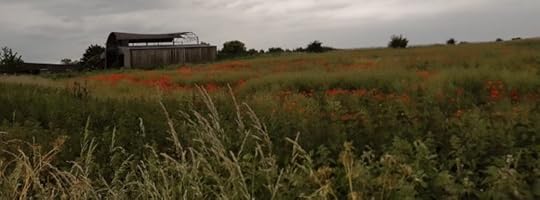 More poppies, spotted on my way home from Newark Park
More poppies, spotted on my way home from Newark Park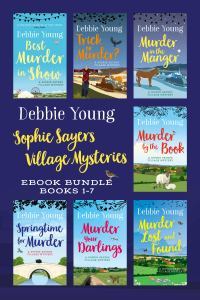 Follow the changing seasons of the Cotswolds year from one summer to the next in this seven-book series
Follow the changing seasons of the Cotswolds year from one summer to the next in this seven-book seriesSERIES OF GENTLE MYSTERY NOVELS INSPIRED BY THE SEASONS IN THE COTSWOLDS
Watching the changing seasons in the Cotswolds is one of the inspirations for my Sophie Sayers Village Mysteries series, which follows the course of village life from one summer to the next through the eyes of newcomer Sophie Sayers.
Click here to find out more about this seven-book series.
Order the first ebook in the series here.
Order the paperbacks online here.
Or ask your favourite local bookshop to order from their usual stockist, quoting ISBN 978-1911223139.
All the books in the series are available in both paperback and ebook, and Best Murder in Show is also available as an audiobook (order direct from me via this link for a very special price), and production is about to start on the audiobook of Trick or Murder?
July 28, 2021
Travels with my Books #7: To Italy with Jean Burnett
 Fran Kempton at work in her study
Fran Kempton at work in her studyI’m delighted to welcome Jean Burnett to the Travels with my Book spot. Jean’s extensive travels have inspired her historical novels, which she writes under her own name and also as Fran Kempton.
Jean has also written a travelogue, Vagabond Shoes, and compiled and edited A Victorian Lady in the Himalayas, the memoirs of intrepid Victorian traveller, Maria Caroline Bolitho.
In our interview, she’ll be focusing on her latest historical novel, The Devil’s Tune, published under the pen-name Fran Kempton. This is the first of a planned Italian trilogy, featuring a composer, an artist, and a dancer.
Jean, welcome to my blog! I read The Devil’s Tune when it was first published and I really enjoyed it, so I’m glad to have this opportunity to spread the word about it. Can we please kick off by pinpointing your book’s geographical settings.
It’s set in Naples, Southern Italy. References to Naples are also in my second book in the series, as yet unpublished.
Please whet our appetites with a brief description.
It’s a novel of music, murder and revenge, set in sixteenth-century Italy, based on the life of the composer Carlo Gesualdo, prince, composer and murderer – or to give him his full title, Carlo Gesualdo da Venosa was Prince of Venosa and Count of Conza.
(Gesualdo is best known for his madrigals and eerie sacred music that use a chromatic language not heard again until the late nineteenth century – find out more about Gesualdo here.)
The book is narrated by Laura Scala, maidservant to the prince’s murdered wife. She swears revenge on the prince and pursues him throughout their lives with disastrous results.
There’s also a cameo appearance from the artist Caravaggio.
What is special about the location?
It’s such a dramatic location, historically and geographically.
What is your relationship with (Italy) and how much of your life have you spent there?
I have always loved Italy and I worked there for several months. I agree with Henry James: “Why be anywhere when you can be in Italy?”
What is special about the people native to Naples?
I think Neapolitans past and present are a bit mad, probably because they live next to a volcano!
Your protagonist, Laura, comes from Sicily. What challenges does she face dealing with Neapolitans?
She finds the city overwhelming and dangerous. There were many Spanish soldiers in Naples as it was ruled by Spain at the time.
What are the distinguishing features of Naples in terms of geography, geology, flora, fauna or any other detail you care to mention?
The volcano, Mount Etna, overshadows everything. The city is huge and chaotic. The bay is absolutely beautiful. There are/were huge gulfs between the rich and the poor. The princes and dukes may have gone, but the Mafia is still very powerful.
What are your top tips for any readers planning to travel to Naples?
Enjoy! The food, the art, the scenery, and the people. But beware of pickpockets and bottom-pinchers!
“Only in Naples” – name three things that could only exist/happen there!
You find the best ice cream in the world in Southern Italy.Museums always seem to be closed ‘for restoration.’The banks are the slowest in Europe, including their ATMs.Which other authors’ books set in Italy would you like to recommend?
The English novelist Amanda Craig has set some of her novels in Italy (Tuscany). Of course, there are the fantastic Inspector Montalbano novels by Andrea Camilleri, also shown on TV, and I recommend the cosy crime/humorous Auntie Poldi books by Mario Giordano, all set in Southern Italy.
Where is your latest book set?
My current work-in-progress, about the Renaissance artist Artemisia Gentileschi, is set In London, with flashbacks to Italy.
Where will your next book be set?
The third book will be set all over Europe, but especially in Italy.
Jean, thank you for sharing your passion for Naples and Southern Italy with us, Jean, and for giving me permission to reproduce the following extract from The Devil’s Tune, in which the narrator, Laura, has just arrived in Venice.
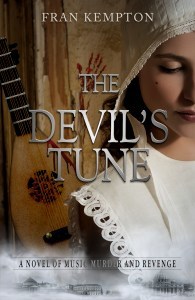 The first in Jean Burnett’s planned Italian trilogy
The first in Jean Burnett’s planned Italian trilogyEXTRACT FROM The Devil’s Tune by Fran Kempton
I wandered along the bank of the canal feeling tired, dirty, and hungry. The few coins in my purse would barely buy a night’s lodging – a meal was out of the question.
Later, moonlight gleamed down on me as it had done once before on a road in Sicily. All around me the gently susurration of moving water and the rustling of foraging rats provided the only sounds, except for the loud rumblings of my empty belly. Without another thought, I curled up at the water’s edge, too tired to care about the danger. The next moment I had tumbled over into the canal in the darkness, my bundle still clutched in my hand.
Later…
An old woman sat in a chair near the window mending a shirt by the light of one flickering candle. She looked up in astonishment at the man’s bedraggled burden, holding up the candle for a closer inspection.
What have you brought me, my son?’ Gaetano dropped me on to the floor unceremoniously. ‘I fished her out of the canal, mother. She needs help.’
To find out more about Jean Burnett/Fran Kempton, visit her website, www.jeanburnett.co.uk.
NEXT MONTH:
We’ll have a complete change of scene and climate when Helena Halme takes us to her native Scandinavia.
PREVIOUS POSTS IN THIS SERIES:
To Fiji with B M AllsoppTo the Caribbean with Helen HollickTo Europe and Roma Nova with Alison MortonTo Egypt with Carol CooperTo The Fair Land with Lucienne BoyceAround the world with Clare FlynnOr take a trip to the Cotswolds any time, through the pages of my own novels and novelettes.
July 23, 2021
The Alternative Staycation: A Trip Down Memory Lane
In my Young By Name column for this month’s Tetbury Advertiser, I shared the heartwarming experience of taking my father to visit his boyhood haunts near Moreton-in-Marsh, Gloucestershire. His love of the Cotswolds from his experience as an evacuee during World War II is the reason I grew up wanting to live in the Cotswolds myself. I moved here over 30 years ago.
Here’s one way you can stop foreign travel restrictions spoiling your summer holiday this year: take a trip back in time instead. You don’t even need a time machine, HG Wells style.
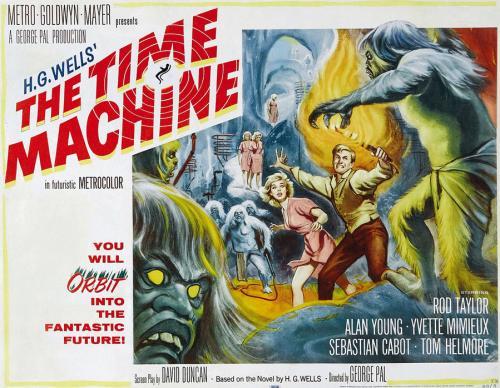 Original movie poster by Reynold Brown – now in public domain, via Wikipedia.
Original movie poster by Reynold Brown – now in public domain, via Wikipedia.Instead, take yourself to a place in this country that was important to you in your past. Such trips can spark treasured memories that lurk in the back of our locked-down brains, as well as providing the opportunity to create new ones.
A couple of weeks ago, I did exactly this, albeit by proxy. I took my 88-year-old father for a day trip to the Cotswold village of Todenham, near Moreton-in-Marsh.
Two days after his seventh birthday – and the outbreak of the Second World War – my father, his two sisters and their mother had been evacuated to Todenham from the London suburb of Sidcup, on the edge of Kent. They considered themselves fortunate to be able to lodge as a family with my grandmother’s stepfather and his second wife, rather than being separated and sent to strangers, as so many evacuees were.
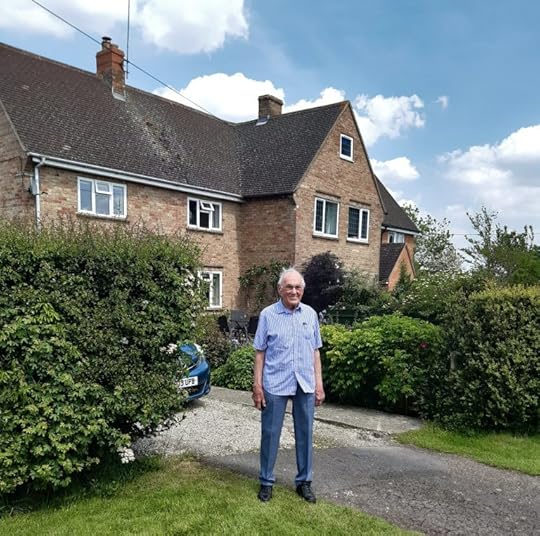
This year (2021), on a glorious early summer’s day, together with my sister and my daughter, we toured territory that was still very familiar to my father.
The little village has not changed much in the last eighty years, at least on the outside.
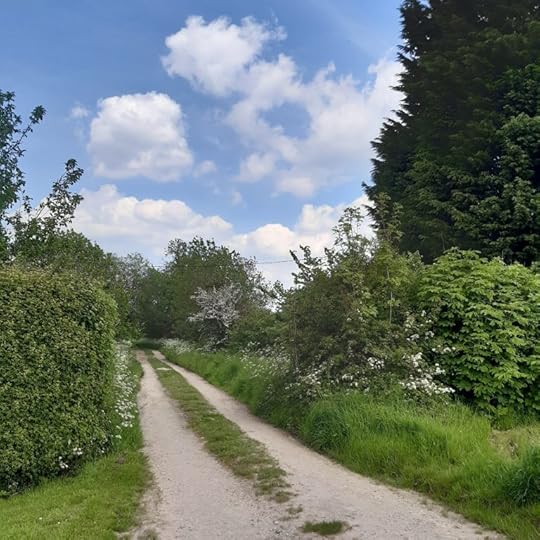 The lane beside his house had barely changed at all
The lane beside his house had barely changed at allWe enjoyed listening to my father’s recollections of his time at the village school, watching the village blacksmith at work, hunting for souvenirs from an enemy plane that crash-landed in a nearby field, and enjoying cosy family evenings playing games, reading and drawing by lamplight around the kitchen table.
 View of the church from where my father’s stepgrandparents now lie at rest
View of the church from where my father’s stepgrandparents now lie at restWhen we knocked on the door of the cottage in which he had lived in those days, the current owner – whom, we were glad to see, was taking excellent care of the house and garden – was hospitable and sympathetic. Although relatively new to the village herself, she was able to share news of many people he remembered from his childhood. His friend Dorothy Duckett had become a primary school teacher, for example, and his younger sister’s friend Valerie Poole had moved away but later returned to retire to the village they all loved.
We strolled around the village, going to visit the village school (now the village hall) and the parish church which as a young evacuee he had attended every Sunday. Inside the church, an elderly lady, one of the churchwardens, was welcoming visitors.
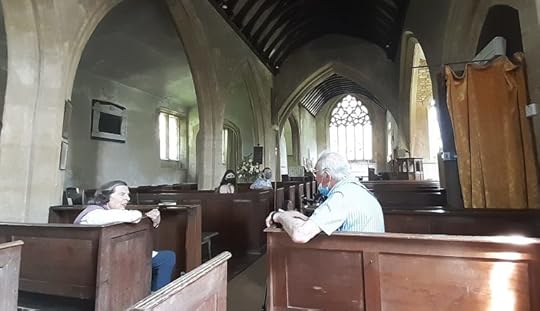 Chatting to the churchwarden in the church he’d attended every Sunday as a boy
Chatting to the churchwarden in the church he’d attended every Sunday as a boyAfter a few moments of chatting to her, my father asked in sudden recognition, “Are you Valerie Poole?” Indeed she was, and together they shared memories that had lain dormant for over 80 years.
We returned from our day trip as refreshed, moved and inspired as from any foreign holiday. So if you’re wondering where to go this summer, you could do worse than visit your old haunts, wherever your roots may be.
As L P Hartley said in the famous opening line of his novel The Go-Between, “The past is a foreign country”. Best of all, there’s no compulsory quarantine when you return.
 My dad with Valerie Poole – eighty years since they were last at the church together
My dad with Valerie Poole – eighty years since they were last at the church togetherFootnote: We’re now planning a return visit including my father’s younger sister.
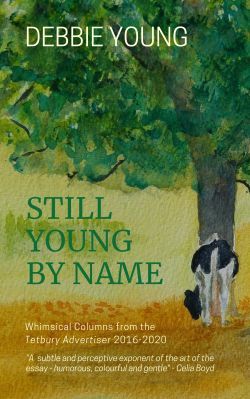 The second volume includes 2016-2020
The second volume includes 2016-2020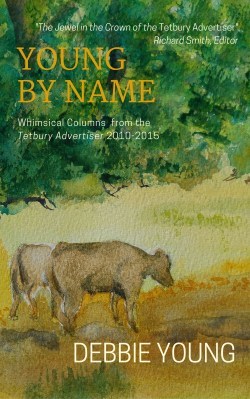 The first volume covered 2010-2015.
The first volume covered 2010-2015.My father’s love of the Cotswolds inspired the watercolour painting that I used for the covers of my collections of columns for the Tetbury Advertiser.
HOW TO ORDER
Both collections are available to buy in paperback and ebook.
Order the paperbacks from Amazon via the links below or ask your local bookshop or library to order copies in for you (available from their usual stockists).
Order the ebooks for the ereader of your choice here:
Young by Name ebook (2010-2015)
Read the whole of the July 2021 issue of the Tetbury Advertiser online here.
July 8, 2021
What’s in a Name?
The naming of the new bells in our parish church inspired my column for the July 2021 edition of the Hawkesbury Parish News
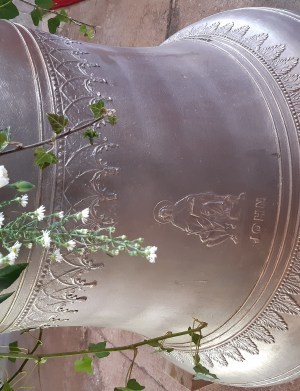 The bell John, decked out in flowers for the blessing ceremony
The bell John, decked out in flowers for the blessing ceremonyThe closest I’ve been to a christening for many years is the blessing of St Mary’s new church bells last month, in which each one was given its official name.
Only afterwards did I realise the significant difference between the choice of names for bells and for babies:
Bells arrive fully formed and their purpose in life is clear.With babies, it’s all still to play for: how the little bundle will turn out in adulthood is anyone’s guess, although their given name will likely reflect parental aspirations.Thus, when naming bells, there is no need to consult any baby name books or The Times’ most popular names list for that year. Bells’ names are typically those of apostles and saints, indicating their devotion to the church. St Mary’s are thus Matthew, Mark, Luke, John, James, Mary, Arild and Wulfstan.
The Naming of CharactersAs a novelist, I’m in a similar position with my characters: I choose names to suit their traits in adult life, rather than to reflect their parents’ ambitions at their birth.
I do however consult official lists of names popular at their date of birth to ensure I don’t end up with anachronisms. Deborah, for example, has not been in the top five since four years before I was born, and I long ago resigned myself to being my generation’s equivalent to a Gladys in my old age.
Masterful NamersI’m in awe of masters of the art of naming fictional characters, such as Charles Dickens and P G Wodehouse, even though the cynic might find their choices larger than life.
Would Mr and Mrs Squiers, parents of the future cruel headmaster of Dotheboys Hall in Nicholas Nickleby really have had the foresight to name their son Wackford?Might Bertie Wooster’s awkward chum Gussie, obsessed with newts, be likely to inherit the surname Fink-Nottle? To my mind, it doesn’t matter – it’s all part of the fun. We named our kittens Bertie and Bingo after the comical characters in PG Wodehouse’s novelsNominative Determinism
We named our kittens Bertie and Bingo after the comical characters in PG Wodehouse’s novelsNominative DeterminismWhether or not you believe in nominative determinism – the notion that your name anticipates your status in life (Nomen est omen, as the Ancient Romans neatly put it) – it’s hard not to rejoice when you find a real-life example:
Keith Weed, President of the Royal Horticultural Society, I wish you the best of luck.
To find out how the leading characters in my Sophie Sayers Village Mysteries got their names, read these posts from my blog archive:
June 30, 2021
Travels with my Books #6: Around the World with Clare Flynn
 Meet Clare Flynn, award-winning historical novelist, whose stories take us all over the world
Meet Clare Flynn, award-winning historical novelist, whose stories take us all over the worldThis month, I’m delighted to welcome Clare Flynn to the Travels with my Book spot. Clare is one of the best-travelled people I know, having visited many of the settings of her historical novels, as well as completing a round-the-world cruise a couple of years ago. In our interview, she’ll be focusing on her series set in Malaysia.
Clare, welcome to my blog! I’m so please to have this opportunity to chat about your travels and your writing life. Can we please kick off by pinpointing your books’s geographical settings.
My historical novels are set all over the globe. Geographic displacement is one of my “things” – UK, Australia, India, Malaysia, Canada, the USA, Italy, Kenya, Sri Lanka, Ireland and France.
Some places only feature briefly, but Australia, India, Canada and Malaysia are all prominent. For “Travels with my Book” I’ve chosen Penang, Malaysia as I have three books set there and I’m writing a fourth which, whilst mostly located in Paris, also returns to Malaysia – or Malaya as it was before independence.
Please briefly describe the books you have set there.
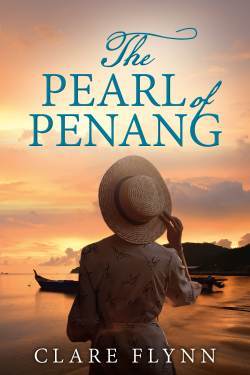 The first in Clare Flynn’s Penang trilogy
The first in Clare Flynn’s Penang trilogyThe Pearl of Penang is Evie’s story. She escapes penniless spinsterhood working as a lady’s companion, when she impulsively accepts a proposal from a man she barely knows and sets sail to the island of Penang to marry him. Things don’t turn out as she expected and a tumultous time awaits her, culminating in the 1941 Japanese invasion.
Prisoner from Penang is Mary’s story. She is Evie’s best friend in Penang. Her story begins with the Fall of Singpore, then to Japanese prison camps in Sumatra (if you’re old enough, think Tenko!) before returning to the island of Penang.
A Painter in Penang is Jasmine’s story. She’s Evie’s stepdaughter who in 1948 flees her miserable school in Kenya to return for an extended stay in Penang as the guest of Mary. This book is a coming of age story set against the backdrop of the Malayan Emergency (a civil war in all but name)
What makes Penang such a great setting for your stories?
Penang is a beautiful tropical island just off the coast of Malaysia and connected by ferry – or these days two Chinese-built road bridges. Lapped by the warm waters of the Strait of Malacca, it is a magical isle, mountainous in the centre and covered with rainforest. There are attap-roofed houses, raised off the ground, brightly coloured Chinese temples, old colonial houses and hotels and the capital George Town is now a Unesco Word Heritage site.
Malaya was one of the jewel’s in the crown of the British Empire – the centre of the world’s rubber industry as well as tin and bauxite mining. Penang itself was acquired in the late eighteenth century by the British East India Company as a port and military stronghold to keep a check on the Dutch and the French who were also busy colonising southeast Asia.
My books begin much later, in 1939, just before the war began in Europe. Malaya and Singapore were never expected to fall to the Japanese in World War II. Indeed Singapore was seen as invincible and its capitulation was a massive humiliation for the British.
What is your relationship with Penang and how much of your life have you spent there?
Don’t laugh – but less than a day! Surely the most profitable day of my entire life!
The brevity of my stay is because it was a port of call on a round-the-world tour. I was halfway through the cruise and had no inclination to write (unusual for me). But I couldn’t get Penang out of my head. By the time we emerged from the Suez canal on the return leg I was bashing away at the keyboard.
Back home, as I researched wartime Malaya, I realised I had struck a rich vein, and now I’m writing number my fourth book in the series. I intended to return to Penang for an extended visit, but Covid and other plans got in the way!
What is special about the people native to Malaysia?
At the time of my books, Malaya was a British colony. The indigeneous Malays only made up around one-third of the population by the end of World War II, with one-third Chinese, and the rest a mixture of Indians and Europeans, mostly British – the latter being the smallest minority but with their hands on government.
After the war, the demise of the British Empire was on the cards and the plan was to achieve a smooth transition to independence. But politics is a complex game and there were many conflicting interests to balance. The British had always “co-ruled” with the sultans. And the sultans neither liked nor trusted the Chinese. There was also a growing fear of communism, balanced by a British Labour government who were reluctant to be openly hostile to China and Russia and who were keen to encourage trade unionism.
It’s not fair to sum up the situation in a few sentences but it makes for a fascinating patchwork of often changing loyalties and conflicting interests.
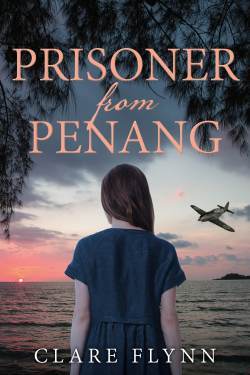 The second in Clare Flynn’s Penang series
The second in Clare Flynn’s Penang seriesFor your characters who come from elsewhere, what challenges do they face dealing with the local people?
The British colonials were incredibly arrogant and complacent before the war. They got on well enough with their colonial subjects in Malaya but had an innate sense of racial superiority. The same attitude was the root cause of their abject failure to prevail against invasion by the Japanese, completely underestimating their enemy. Their humiliation was made greater when it became apparent that the primary form of transport used by the advancing Japanese army was bicycles! The British had never anticipated such a simple and practical solution to shifting an army on poor roads the length of the peninsula.
After the war, they made the mistake of assuming those Malays (mostly Chinese Malays) who had fought bravely behind the Japanese lines alongside Special Operations soldiers would be loyal once the peace came. But the tons of ammunition air-dropped into the jungle by the British to fight the Japanese were buried in secret caches, and, rather than handing them in, the rebels later used them to fight their former British comrades in what proved to be an ultimately doomed twelve-year struggle.
For the women in my Penang novels, the challenges are mainly with their fellow Brits. Evie and Mary, and to some extent Jasmine, have little time for the cliquey clubbiness of the ex-pat British. For Mary there is the living nightmare of imprisonment for years by the Japanese. Later, for Jasmine, it’s reconciling her feelings for a native Malay and her ambivalence towards the communist insurgents.
What are the distinguishing features of Penang in terms of geography, geology, flora, fauna or any other detail you care to mention?
A small island surrounded by a tropical sea and topped by rainforest. Hot and humid with frequent rain. Historic George Town faces across the Strait to the peninsula and the Kedah hills. It is an island of spices with the aromatic smells of delicious cooking everywhere. The multi-ethnic food is delicious. The coastline is rocky with outcrops and miniature islands in the sea, which is dotted with fishing boats and passing liners. The beaches are fringed by casuarina trees. Wildlife includes giant red flying squirrels, monitor lizards, long-tailed macaques, flying lemurs, tree shrews, snakes – including boa constrictors, wild pigs and sea eagles.
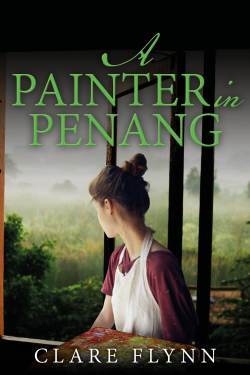 The third in Clare Flynn’s Penang series
The third in Clare Flynn’s Penang seriesWhat are your top tips for any readers planning to travel to the setting of your book?
I may not have had the chance to stay there myself (yet),but I had done a lot of planning for my aborted trip. I intended to stay in the Eastern & Oriental Hotel (the E&O) which features in my books – as well as in a picturesque guest house converted from a former Chinese merchant’s house – as well as a couple of days staying at the beach.
George Town itself offers plenty to fascinate from its delicious cuisine, to its famous street art, colonial architecture and old Chinese wooden quays.
A visit via the funicular railway to the top of Penang Hill is essential for the panoramic views of George Town and the Straits as well as walks in the rainforest. The more energetic can hire a bicycle and cycle beside the paddy fields and spice plantations to explore the island.
Are there any other authors’ books with the same setting that you’d like to recommend?
I haven’t read it yet, but I’ve heard great things of The Gift of Rain by Tan Twan Eng, set in Penang in 1939. It’s about an Anglo-Chinese man and his friendship with a Japanese diplomat. I have a copy in my TBR pile and am looking forward to reading it. While I was researching my Penang books I avoided reading fiction and read a lot of non-fiction accounts of colonial life. I did dip in and out of Somerset Maugham’s short stories though, many of which are set in colonial Malaya. He was not a popular figure among the British there, who thought he painted a very unflattering picture of them.
Where will your next book be set?
It starts in Nairobi, Kenya, but most of the action takes place in Paris – with a few returns to Penang and to Johore on the peninsula between Kuala Lumpur and Singapore. It follows on from the three Penang books, continuing Jasmine’s story.
Thank you very much, Clare, for sharing with us the fascinating history of Penang and its influence on your writing.
You’re welcome! A delight to be a guest on your blog, Debbie!
EXTRACT FROM THE PEARL OF PENANG The first in Clare Flynn’s Penang trilogy
The first in Clare Flynn’s Penang trilogyAfter strolling past the bastion of Fort Cornwallis with its thick brick walls, Evie turned off and plunged into the nearby streets. Eventually finding herself in a square with a collection of stalls and kiosks, her nose and throat were assaulted by an overpowering, sweet smell of incense. Across the square was a small temple, with the characteristic Chinese swooping curved roof, adorned along the ridge with dragon carvings. There were shrines and stone statues outside, where people gathered to thrust bunches of smouldering joss sticks into jars filled with sand, before bending or squatting in prayer and devotion. Looking around, she could see no other Europeans, but no one seemed bothered by her presence so she walked freely around the space. There was a covered well, where people were collecting water, and piles of stacked wooden cages each containing a small bird. The square was a peculiar mixture of sincere devotion and casual commerce.
Hesitantly, Evie went up to the entrance of the temple building and was glad to find it quiet and almost empty inside, although the scent of the burning incense was more intense than in the square.
The light was dim, provided only by the faint glow of candles and the daylight from the narrow open doorway she had entered through. She squinted to see. In front of her was a small gold-painted shrine. Evie moved towards it and stood for a while in silence, drinking in the calm and quiet of the place after the chaotic scene outside. Her eyes adjusted to the gloom and she saw the shrine was crowded with a collection of painted figures, the male ones dressed like emperors in ornate robes with long drooping moustaches, one or two goddesses, other figures resembling evil-looking ogres, and among them gold-painted animals such as horned deer or sea creatures. Oranges and other fruits were stacked in neat piles with what she assumed to be votive messages written in Chinese on little cards. The smell of burning joss sticks was intensified by the perfume from flowers, stacked around the shrine in tall vases. Curved metal lanterns and red streamers hung from the ceiling.
Evie was transfixed by the scene and felt a strange calm enveloping her after all the trauma, fear and bitterness of the past days. Without thinking why, she stood with her head bowed and closed her eyes.
To find out more about Clare Flynn and her 13 (and counting!) historical novels, visit her website, www.clareflynn.co.uk, where if you join her mailing list, you will be able to download a free collection of short stories.
NEXT MONTH:
We’ll have a complete change of scene and climate when Helena Halme takes us to her native Scandinavia!
PREVIOUS POSTS IN THIS SERIES:
To Fiji with B M AllsoppTo the Caribbean with Helen HollickTo Europe and Roma Nova with Alison MortonTo Egypt with Carol CooperTo The Far Land with Lucienne BoyceOr take a trip to the Cotswolds any time, through the pages of my own novels and novelettes!
June 23, 2021
Why I Publish Books on Special Days
A post about how I choose launch dates for my novels plus a quick survey of other authors’ preferences
While I don’t consider myself to be superstitious, I’ve got into the habit of publishing each new book on a date that is personally significant to me.
Choice of publishing date is a luxury that only independent authors can enjoy:
We call the shots ourselves, rather than being dependent on the huge engines of trade publishing companies, which typically take a year or more to launch a book from the date the author delivers the final manuscript.
My first novel, Best Murder in Show, was launched on 1st April, 2017 – not because I was staging it as a practical joke for April Fool’s Day, but because it happens to be the birthday of my good friend and mentor, Orna Ross, author, poet, and founder of the Alliance of Independent Authors, for which I’m the UK Ambassador.
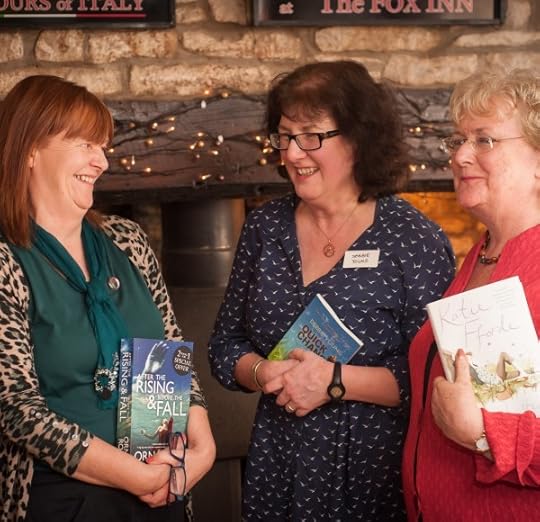 Having fun with Orna Ross and Katie Fforde at the first Hawkesbury Upton Literature Festival in 2015 (Photo by Clint Randall)
Having fun with Orna Ross and Katie Fforde at the first Hawkesbury Upton Literature Festival in 2015 (Photo by Clint Randall)For my most recent novel, Murder Lost and Found, I chose my daughter Laura’s 18th birthday. Not only was it of course Laura’s majority, but the novel marked a kind of coming of age for Sophie Sayers too, marking the end of her first year in her adopted village of Wendlebury Barrow and a new confidence and assurance for Sophie that has been developing throughout the series.
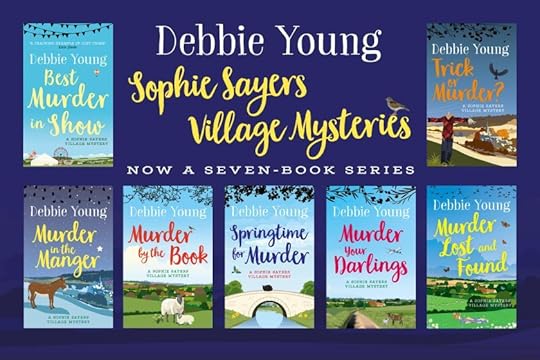
However, Murder Lost and Found won’t be the last you will hear of Sophie Sayers: I’m planning an eighth adventure for her, A Fling with Murder, for next year, and further spin-offs in my Tales from Wendlebury Barrow series of novelettes.
Which Dates Do Other Indie Authors Choose?Being able to publish on dates that are important to me gives me great satisfaction – the icing on the cake of completing a project – but I wondered whether this habit was just personal whimsy or common practice. When I asked some author friends, I was gratified to find I’m not alone in my approach, as these examples show:
 Historical novelist Clare Flynn, on her latest novel, Sisters at War, set in Liverpool during the Second World War:
Historical novelist Clare Flynn, on her latest novel, Sisters at War, set in Liverpool during the Second World War:
“I chose May 1st 2021 to launch Sisters at War as it was the 80th anniversary of the terrible May Blitz on Liverpool in 1941.”
(Find out more about that tragic event here: https://www.liverpoolmuseums.org.uk/liverpool-and-may-blitz-of-1941)
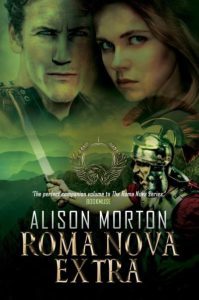 Alison Morton, who writes alternative history and thrillers, decided to make her Roma Nova short story collection a gift to herself:
Alison Morton, who writes alternative history and thrillers, decided to make her Roma Nova short story collection a gift to herself:
“This was the first time I’d dared to put together a collection of short stories, so I thought it would be fun to give birth to it on my own birthday on 19th October. The stories supplement, precede or follow the stories in the core Roma Nova novels – little episodes of their own. It was delightful to wake up to a mix of “Happy publication day” and “Happy birthday” greetings. I drank bubbly that evening in double celebration.”
Other author friends have published to honour family members – for example, Pauline Baird Jones will launch Cosmic Boom on her late mother’s birthday, 20th July, and Kristina Adams published her non-fiction book, Writing Myths, on her grandmother’s birthday the year she passed away.
 Tom Evans has a very appropriate strategy for Soulwaves : A Future History and Soulwaves: Insertions, both of which feature the Moon almost as a character:
Tom Evans has a very appropriate strategy for Soulwaves : A Future History and Soulwaves: Insertions, both of which feature the Moon almost as a character:
“I published on the first new moon of the year, this year and last, and then followed up with snippets of ancillary, augmenting content every subsequent new and full moon. My choice of date may have no significance, but it keeps me aiming at something – with a reminder in the sky when not cloudy!”
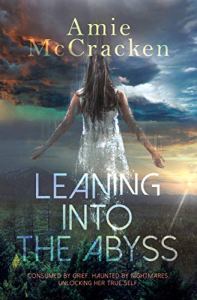 Amie McCracken had a very specific reason for fixing the launch date for her latest novella, which is set in the USA and Mexico:
Amie McCracken had a very specific reason for fixing the launch date for her latest novella, which is set in the USA and Mexico:
“I chose the Day of the Dead for Leaning Into the Abyss because it features as the day my protagonist finally figures out her life! (And it’s a story about grieving for a lost loved one.)”
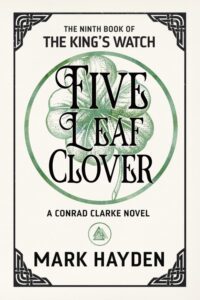 Mark Hayden had a more pragmatic approach for the ninth in his King’s Watch fantasy series:
Mark Hayden had a more pragmatic approach for the ninth in his King’s Watch fantasy series:
“Some indie authors are a lot more casual about publication. I adhere to the belief that the best day to publish a book is yesterday, and I put them out as soon as they’re ready. However, even I admit that I rushed out the ebook of Five Leaf Clover a good week ahead of the paperback because the UK bank holiday weekend was coming up and I wanted to give my readers an incentive to buy it. I also admit that my wife did once tell me that under no circumstances could I publish a book on her birthday. I know my priorities.”
Which Book Will I Publish Next?So when will I be publishing my next book and what will it be?
Mrs Morris Changes Lanes , a new standalone novella – fingers crossed for 1st August (my maternal grandmother’s birthday) Scandal at St Bride’s , the third St Bride’s School novel – before the end of the 2021 (exact date yet to be decided)I’m also writing May Sayers Comes Home, a novella about Sophie Sayers’ aunt; a travel memoir, Travels with my Camper Van, and planning new additions to the Tales from Wendlebury Barrow series of novelettes.
So I’d better get off my blog now and get writing!
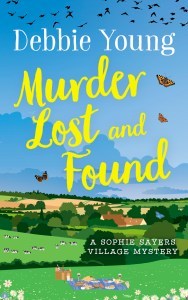
HOW TO ORDER MURDER LOST AND FOUND
Order the ebook from a choice of retailers here.
Order the paperback online here.
Or ask your local high street bookseller to order it for you, quoting ISBN 978 1911223719.
June 16, 2021
Running to Stand Still
In my Young By Name column for the Tetbury Advertiser ‘s June issue, I’m anticipating a return to almost-normal life – and being careful what I wish for.
Inheriting my parents’ strong work ethic and optimism, I have developed a lifelong tendency to try to do more than is physically possible in the available time. Even so, people often remark that I’m prolific, usually in the same breath as asking me to do something for them on the old “ask a busy person” principle. (I really need to learn to say no.)
The upshot is that most of the time, like the Red Queen in Lewis Carroll’s Alice Through the Looking Glass, I feel as if I’m running to stand still. “It takes all the running you can do to keep in the same place,” the Red Queen tells Alice. “If you want to get somewhere else, you must run at least twice as fast as that.”
I occasionally write a ‘done’ list to prove to myself that I have been more productive than I think, but who has time to do that every day?
 (Image by John Tenniel for Lewis Carroll’s “Alice Through the Looking Glass” in public domain)
(Image by John Tenniel for Lewis Carroll’s “Alice Through the Looking Glass” in public domain)Jumping Off the Treadmill
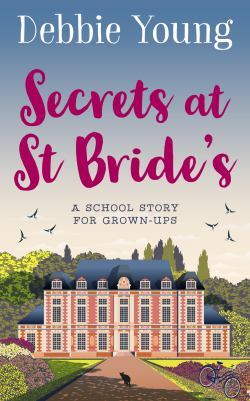 I loved the pattern of the year working in a boarding school, alternating between busy term-time and long holidays – the inspiration for my series of school stories!
I loved the pattern of the year working in a boarding school, alternating between busy term-time and long holidays – the inspiration for my series of school stories!When in 9-5 jobs I stepped off the treadmill for holidays, I was conscious that my work would come to a standstill while others beavered away in my absence. My favourite time to take a break was therefore during the Christmas/New Year break, when almost everyone else went on leave too.
When I worked on a year-round contract in a school office, I rejoiced every time term ended, because in the absence of teachers and pupils, much as I loved them, I felt I had time to catch up with myself.
Stopping the World
To help me stay on top of all my tasks, I used to wish I could put the rest of the world on hold, in the manner of Sleeping Beauty’s fairy godmother making the kingdom sleep for 100 years. My only proviso was that I wouldn’t age a century by the time I woke everyone up again. What a shock that would be for my poor husband!
Covid-19 has put paid to that fantasy for good.
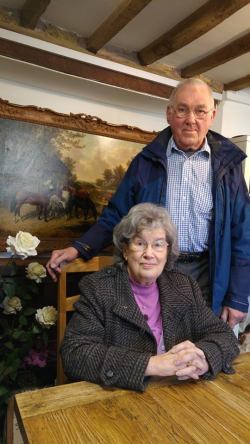 My parents on their 65th wedding anniversary, when we took them to Bourton-on-the-Water
My parents on their 65th wedding anniversary, when we took them to Bourton-on-the-WaterAs we emerge, blinking, from the quasi-hibernation of lockdown, I’m hoping this past year is the closest I will ever get to casting that magic spell. As I predicted in the April 2020 issue of the Tetbury Advertiser, for me lockdown resulted in tidier bookshelves, larder, wardrobe, etc, and I’m pleased about that. But going forward, my priorities have changed.
Top of my to-do list post-lockdown will be hugging my parents.
That’s one action I’m happy to keep adding every day.
June 2, 2021
The Call of the Bells
In this month’s Hawkesbury Parish News, as new bells arrive at our parish church, I’m reflecting on bell ringing and bell ringers in English churches and explaining why I’m taking up bell ringing.
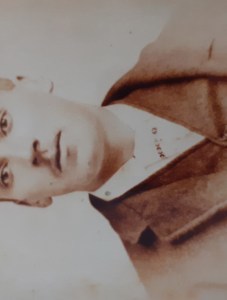 My great grandfather, Bill Shimmans, was an accomplished bell ringer
My great grandfather, Bill Shimmans, was an accomplished bell ringerEver since I learned that my great-grandfather, born in 1873, was an accomplished bell ringer, I’ve felt an affinity to church bells, but never had the chance to learn to ring them. Now that I’m training to ring the new bells of our parish church, I’ve been finding out some fascinating facts about bell ringing – or rather, sounding the depths of my ignorance.
I’d never realised that each church bell has to be tuned to a precise musical pitch. I hadn’t even classified bells as musical instruments. Now I know they are the loudest musical instrument of all.
Nor had I appreciated that in other countries bells are commonly hung and struck in a different way. I thought “carillon” was the name of a tune played by bells, as in Bruges’ Belfort. Now I’ve discovered it’s the name of the musical instrument used to play tunes on the bells. It’s strung a little like a piano, and each key activates a wire that strikes hammers against the outsides of the bells. A single operator sounds all the bells.
By contrast, in so-called English-style bell ringing, bells are mounted on a headstock allowing them to swing through 360 degrees. Each bell is operated by an individual person, and when the ringer pulls the rope, the clapper strikes the inside of the bell twice during each full rotation.
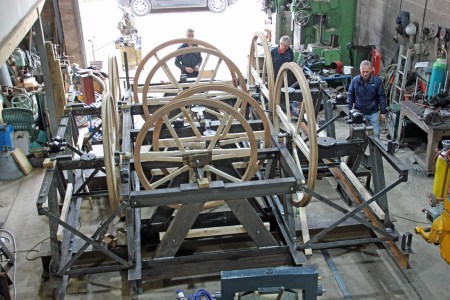 While it was still being constructed in Matthew Higby’s workshop, the framework from which the new bells will be hung (Photo by Sir Ian Macfadyen)
While it was still being constructed in Matthew Higby’s workshop, the framework from which the new bells will be hung (Photo by Sir Ian Macfadyen)Not for English-style ringers the dainty tunes of the carillon. We make life more complicated for ourselves by defining complex and varying mathematical sequences. Each variation in the sequence is known as a change, hence the expression “ringing the changes”.
My family still has my great-grandfather’s certificates and press cuttings for completing eight- and twelve-bell peals of over 5,000 changes apiece in churches in Bedford, London, Middlesex and Kent. The peals bear unfathomable names that characterise English-style change-ringing, such as the Treble Bob Maximus, Stedman Cinques, and the New Cambridge Surprise Major. (I’d love to know what the surprise was!) Each complete peal took at least three hours, even if the ringers did it right first time. One certificate wryly notes completion on the fifth attempt.
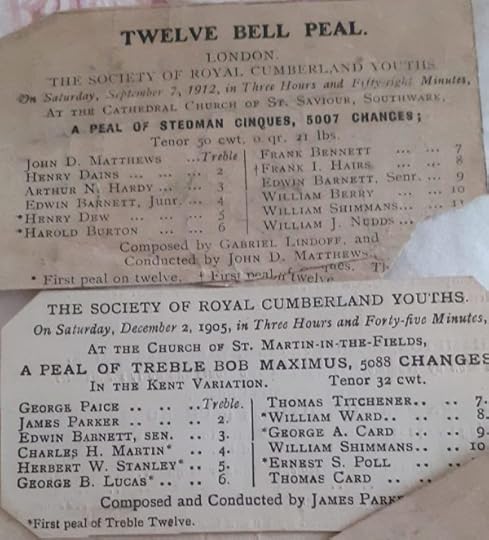 Just a few of my great-grandpa’s records of his bell-ringing career
Just a few of my great-grandpa’s records of his bell-ringing careerMy great-grandfather died three years before I was born, and he passed on his musical genes to my grandpa, who served for many years as choirmaster in the church where my parents were married and where I was christened. It’ll be a long time before I can tackle a peal of the complexity mastered by my great-grandfather. On the dumb bell in Colin Dixon’s barn, I’m still learning how to control a bell and how to ring it consistently and evenly. But the first time I ring in St Mary’s, I’ll be thinking of my great-grandpa and grandpa, and ringing for them.
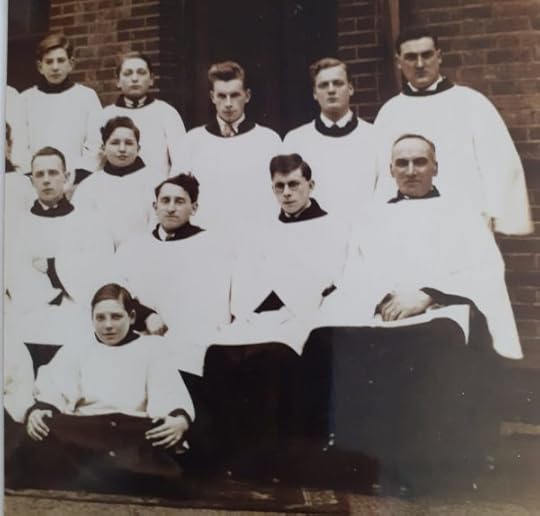 My Grandpa, the choirmaster of the parish church of the Holy Redeemer, Sidcup- top right
My Grandpa, the choirmaster of the parish church of the Holy Redeemer, Sidcup- top rightLike to know more about St Mary’s and its new bells?
Find out more about the beautiful ancient parish church and idyllic setting of St Mary’s, Hawkesbury via our website: www.friendsofstmaryshawkesbury.com (I’m on the Friends of St Mary’s committee and manage this website.)On YouTube, watch the historic service held to bless the bells before they are installed – it’s a service so rare that our vicar had never been involved in one before, and it’s likely that many parish priests are never called upon to do one.Bell-ringing in fiction
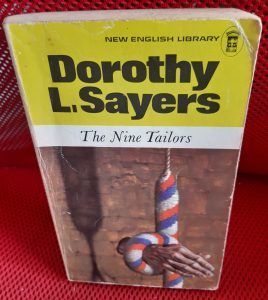 I’m planning to write a story featuring bells at some point, but in the meantime, I’d like to recommend one of my favourite novels that centres around church bells, The Nine Tailors by Dorothy L Sayers – a hugely atmospheric traditional mystery in which a dead body is found in the bell tower of a village in Norfolk, and the iconic amateur sleuth Lord Peter Wimsey investigates. As you can tell from the battered state of the cover, I’ve read it many times. And yes, I named my heroine Sophie Sayers after my writing hero Dorothy L Sayers – and I have a cat called Dorothy!
I’m planning to write a story featuring bells at some point, but in the meantime, I’d like to recommend one of my favourite novels that centres around church bells, The Nine Tailors by Dorothy L Sayers – a hugely atmospheric traditional mystery in which a dead body is found in the bell tower of a village in Norfolk, and the iconic amateur sleuth Lord Peter Wimsey investigates. As you can tell from the battered state of the cover, I’ve read it many times. And yes, I named my heroine Sophie Sayers after my writing hero Dorothy L Sayers – and I have a cat called Dorothy!
In case you missed it…
My column for last month’s Hawkesbury Parish News, entitled “Trust Me, I’m a Bell Ringer“, includes a photo of me practising on the dumb bell with an anecdote of how my new hobby almost got me in trouble with the law.
May 26, 2021
Travels with my Book #5: To the Fair Land with Lucienne Boyce
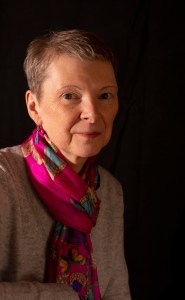 Meet Lucienne Boyce, historical novelist and historian
Meet Lucienne Boyce, historical novelist and historianToday I’m delighted to welcome my good friend, the award-winning author Lucienne Boyce, to tell us about her wonderful eighteenth-century historical mystery novel To the Fair Land. When I first read it, I was captivated from the opening page by the vivid sense of place, which travels from London to Bristol to the mythical “Fair Land” and back again.
I’ve gone on to enjoy her subsequent Dan Foster series of Bow Street Runner mysteries, which to date includes three novels and a novella, and I’m eagerly awaiting the next one. Today, however, Lucienne is going to take us on a voyage to the mystical land at the heart of her first novel.
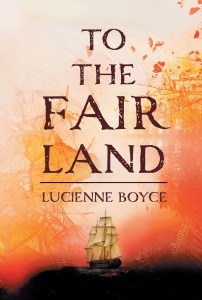 Join Lucienne Boyce for an adventure in search of a mythical land…
Join Lucienne Boyce for an adventure in search of a mythical land…Lucienne, welcome to my blog! Usually the first question I ask my “Travels with my Book” guests is to pinpoint their book’s setting on the globe, but in your case, this is a little tricky – can you please explain why?
To The Fair Land is about, and partly set in, the Fair Land – but I can only pinpoint a theoretical location for it, since it is a mythical land!
Its existence is based on theories of the Great Southern Continent, a great land mass in the southern hemisphere which fifth-century mathematician and philosopher Pythagoras argued must exist in order to balance the land masses in the north.
For the next 2,000 years, map makers confidently included it on their maps, and explorers from many nations went looking for it – Dutch, French, Portuguese, and British. In the seventeenth century the Somerset buccaneer William Dampier tried to find it. He ended up at Australia – then called New Holland by the Dutch explorers who got there before him – which he thought a pretty poor place.
In 1764 the British Admiralty sent John Byron – Foulweather Jack Byron – to the Pacific but he didn’t find anything and some people thought he didn’t try very hard. After him was Samuel Wallis in 1766, who reported sighting the continent.
Then in 1768, the Admiralty sent Britain’s most famous navigator, Captain James Cook, to look for the Great Southern Continent. Cook’s voyage on the Endeavour lasted three years and he didn’t find the Continent. He undertook a second voyage between 1772 and 1775, and it was on that voyage that he demonstrated once and for all – by sailing across it – that there was no Great Southern Continent. But in 1772 his second voyage had only just begun, and it was still possible to believe that the Continent existed.
And that’s where To The Fair Land comes in.
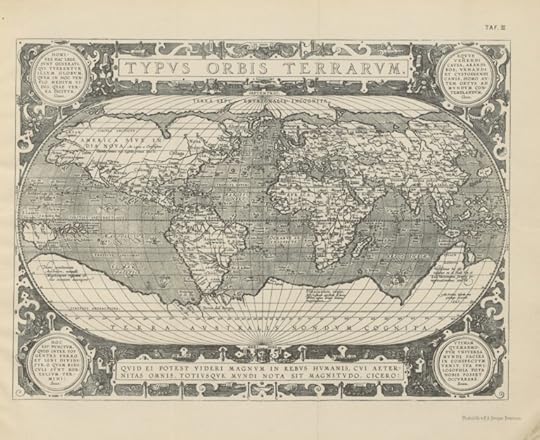 A seventeenth-century map of the world showing Terris Australis Incognita (the Great Southern Continent). (Credit: The British Library on Flickr – no known copyright restrictions)
A seventeenth-century map of the world showing Terris Australis Incognita (the Great Southern Continent). (Credit: The British Library on Flickr – no known copyright restrictions)
Please whet readers’ appetites for the voyage with to the Fair Land with an overview of your book.
To The Fair Land is a historical mystery with elements of fantasy. When, in 1789, struggling writer Ben Dearlove attempts to track down the author of an anonymous, best-selling book about a fictitious journey to the South Seas, he is caught up in a quest much more dangerous than the search for a reclusive author. Before long he finds himself pitted against people who will lie, steal and even kill to stop him discovering the truth abut the voyage of the Miranda.
What makes the Fair Land such a great setting for your story?
Placing a fantasy setting within a researched historical context is a way of reflecting the period in which the book is set and the elements of that history to which I was drawn.
It was a time when our world was still largely unknown, when charts and maps had huge blank spaces in them, and men undertook epic journeys with nothing but four inches of wood between them and destruction. It’s a time when the existence of the Fair Land was still possible.
People believed in the Great Southern Continent on no firmer evidence than that a Greek philosopher had made it up.
It was a myth, yet people still risked their lives looking for it.
The eighteenth century may have been a great age of exploration, but that rational, scientific quest for knowledge was underpinned by dreams and imaginings. That says a great deal about the power of myth!
But the dreams of distant lands were not only about discovery. These exploratory voyages were also motivated by greed and acquisitiveness, and culminated in a devastating process of colonisation and exploitation of other lands.
So the fantasy of the Fair Land is a way of exploring these ideas. It’s also a way of contrasting the values of more technologically advanced societies with the people they look upon as their inferiors.
And, of course, as it’s a fantasy, I can make it what I like!
Another question I always ask guests in this spot, which is not as straightforward for you to answer, is what is your relationship with the country in your novel and how much of your life have you spent there?
I have spent many a happy hour in the Fair Land in my imagination – though it’s tinged with sadness too as I know that the future for the country and its people is bleak since its discovery by “civilisation”.
In fact, I have always thought I might one day write a sequel to To The Fair Land continuing the story of some of its main characters, and exploring what happens next in the Fair Land. [Yes please, Lucienne!]
To The Fair Land is also set in the literary world of London with its coffee houses, book shops and theatres; and in and around the taverns and quays of Bristol. I lived in London for many years, and have walked in many of the places my characters inhabit. I live in Bristol now, and its rich maritime history was a major inspiration for To The Fair Land.
What is special about the people native to the Fair Land?
To The Fair Land has its roots in the tradition of utopias, dystopias and mythical lands that mankind has dreamed of for centuries – the island of Shakespeare’s The Tempest, Charlotte Perkin Gilman’s Herland, Arthur Conan Doyle’s The Lost World, William Morris’s Wondrous Isles, C S Lewis’s Narnia, El Dorado, Camelot…
The Fair Land is a utopia. Its people are strong and healthy, not distorted and crippled by industrial labour, poor housing, starvation or subsistence wages. They are generous, peaceful, and ignorant of the ‘arts’ of war. Their attitudes to property are the opposite of the rapacious explorers who seek to colonise their land. If they argue over property, it is “not for the right to possess, but for the right to give away”. In London, Ben Dearlove sees children begging; in the Fair Land no child is left to go hungry or uncared for – an adult “would no more allow the child of another to suffer than they would allow their own”. They live in a beautiful setting, which is reflected in their love of music, story telling and dancing.
I did say it was a fantasy!

Where is your latest book set?
My latest book is Death Makes No Distinction, the third Dan Foster Mystery. Dan is a Bow Street Runner and amateur pugilist, and the story is set in late eighteenth-century London. Dan is investigating two murders, one of a former mistress of the Prince of Wales in her Mayfair mansion, the other of an unnamed beggar woman found beaten to death in a tavern out-house in Holborn. His investigations take him into both the richest and foulest parts of the city.
The Bow Street Runners of London – or Principal Officers as they preferred to be called – often investigated crimes in other parts of the country. The first Dan Foster Mystery, Bloodie Bones, is set in Somerset, where Dan is sent to investigate the murder of a local gamekeeper during anti-land enclosure protests.
In The Butcher’s Block Dan’s investigation of the murder of a fellow police officer takes him from Southwark, London (involving that huge journey to the south of the river!), to Sheerness in Kent, and back to London.
The Fatal Coin, a prequel novella to the Dan Foster Mysteries, is set in Staffordshire on and around Cannock Chase, as Dan goes on the trail of a highwayman and forger. It’s very much part of the landscape of my childhood, as I was born and brought up in Wolverhampton.
Where will your next book be set?
I’m currently working on the next Dan Foster Mystery, which will be set on Anglesey where Dan goes to bring back a smuggler charged with the murder of a Kentish exciseman.
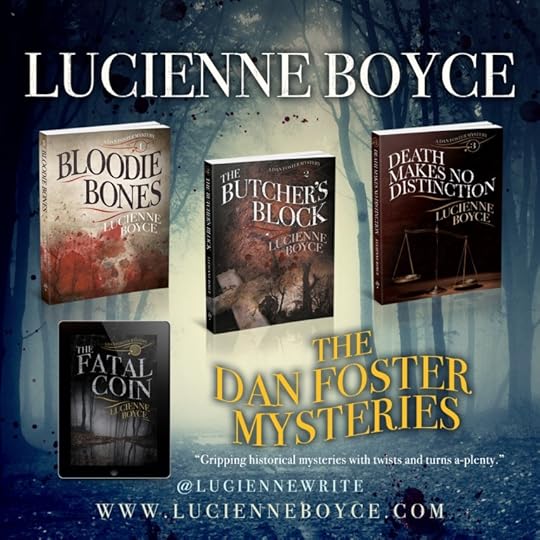 I highly recommend Lucienne Boyce’s Dan Foster series, which roves around eighteenth-century England and Wales, for anyone who enjoys historical mysteries.
I highly recommend Lucienne Boyce’s Dan Foster series, which roves around eighteenth-century England and Wales, for anyone who enjoys historical mysteries.
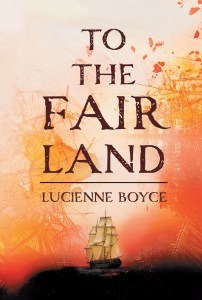 EXTRACT OF TO THE FAIR LAND
EXTRACT OF TO THE FAIR LANDTo the Fair Land opens in a London theatre. In the eighteenth century going to a play was not always the tame past-time it is now. In this scene, Ben Dearlove is at Covent Garden Theatre watching The Life and Death of Captain Cook, a play about the (British version of) the death of the nation’s hero, Captain Cook, in Hawaii.
The Captain flung back his head and announced at length that he was proud to die in the service of his country. Then he ran through a couple of the foe for heroic good measure. His screaming enemies flung themselves upon him and he went down in a flurry of clubs and spears.
The curtain descended and pandemonium broke out. Wailing women flung themselves into one another’s arms. Men were not ashamed to be seen wiping their eyes, or blowing their noses on their sleeves. The spectators in the galleries applauded so enthusiastically it was a wonder there were no broken arms. The theatre echoed with cries of “Cook for England!”, “Bravo Captain Cook!”, and “God Save the King!”
Inflamed by the atmosphere, the front rows rushed the stage, where the boldest and most agile attempted to climb over the spikes, perhaps intending to slaughter the Hawaiians. It was a hot, affecting moment, and Ben and Campbell were on their feet with the rest.
“I’m off backstage before someone else gets there!” said a voice in Ben’s left ear. “Captain Cook was a fool,” hissed another in his right.
“What?” He turned in confusion from side to side.
“You know, the girl the Captain turned down. Catch me turning her away from my bed!” That was Campbell to Ben’s left.
“Captain Cook’s discoveries! A fool’s discoveries – little islands and barren shores. I wouldn’t give you that for Captain Cook’s discoveries!”
The thin woman to his right was a picture of madness, talking, gesticulating, her voice growing shriller and louder. Ben frowned a warning, willing her to be quiet, but she was oblivious to all hints of danger.
“What did she say?” shrieked a female in the next row.
“Why, she says Captain Cook’s a fool!” rejoined her gossip.
“D’ye hear that, gen’lemen?” This to their escorts. “’Ere, Mr Timmins, ask her what she means by it.”
“I ask her? Why don’t you ask her yourself?”
There was no need to ask her anything. She had no thought of keeping her heresies to herself. “Captain Cook found nothing, nothing at all… yet they make a hero of him. A hero of that blunderer!”
“Lookee, miss, don’t you go mullironing a brave and a gallant gen’leman in my ’earing,” cried the first woman.
“No, shut your mouth, you damned bitch!” added Mr Timmins.
“Ay, Mrs Harridan, you can keep your pinions to yourself,” put in a gen’leman in the row behind, leaning forward to give the woman a shove in the small of her back. She stumbled and looked about her in bewilderment. It was only natural for the Timmins ladies to feel that she committed a further outrage with her “obstropolous” look. They appealed to the pit at large: “Did you hear what she said?”
“Yes, and I saw her laugh with the murdering savages.”
“Who does she think she is, coming in and upsetting decent people?”
“Give her a ducking in the water trough!”
“No, roll her in the kennels.”
Heedlessly, Ben’s neighbour babbled on. “He turned back too soon. He didn’t find it. What a mercy is a fool! What would have happened to them all if he had?”
Ben grasped her arm. “Madam, for your own sake, be quiet!”
An orange hit her in the back and she staggered into him. He spied another piece of fruit flying through the air and put his arm around her to ward it off. He missed and it caught her on the shoulder before smashing on the boards at her feet. She looked down at the pulpy mess in astonishment. Gradually it dawned on her that she was under attack. He felt her sudden, panicky resistance to his encircling arm. Before he could assure her that he was not one of the crowd, Campbell tugged at his sleeve.
“Come on, Ben!”
“I can’t,” he said helplessly.
“Why not? Od’s bobs, leave her!”
“They’ll tear her apart.”
“It’s only a Billingsgate fight. Leave them to it.”
Doubtfully, Ben relinquished the woman. Unexpectedly deprived of his support she slumped onto the bench. Campbell was already pushing his way out of the pit. Ben followed. A raucous howl made him look back.
FIND OUT MORE ABOUT LUCIENNE BOYCE
 Lucienne has a terrific website featuring lots of background material related to her books. It is also addresses her other writing passion: the history of the women’s suffrage, about which she’s written two books. She also issues a very well-presented occasional newsletter featuring more interesting information. What’s more, when you sign up for her newsletter, you will receive a free ebook The Road to Representation: Essays on the Women’s Suffrage Campaign – visit https://www.lucienneboyce.com/newsletter/.
Lucienne has a terrific website featuring lots of background material related to her books. It is also addresses her other writing passion: the history of the women’s suffrage, about which she’s written two books. She also issues a very well-presented occasional newsletter featuring more interesting information. What’s more, when you sign up for her newsletter, you will receive a free ebook The Road to Representation: Essays on the Women’s Suffrage Campaign – visit https://www.lucienneboyce.com/newsletter/.
Connect with Lucienne here:
Website: www.lucienneboyce.com
Twitter: www.twitter.com/LucienneWrite
Where to buy To the Fair Land
All of Lucienne Boyce’s books are available in ebook and paperback, apart from The Fatal Coin novella, which is only in ebook.
For a list of places you can buy To the Fair Land, visit its page on her website here: https://www.lucienneboyce.com/to-the-fair-land/
NEXT MONTH:
Suzie Grogan takes us on a grand tour in the footsteps of poet John Keats
PREVIOUS POSTS IN THIS SERIES:
To Fiji with B M AllsoppTo the Caribbean with Helen HollickTo Europe and Roma Nova with Alison MortonTo Egypt with Carol CooperOr take a trip to the Cotswolds any time, through the pages of my own novels and novelettes!



